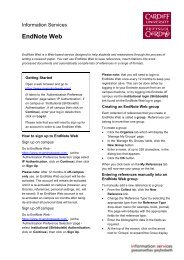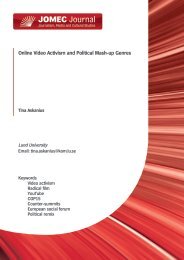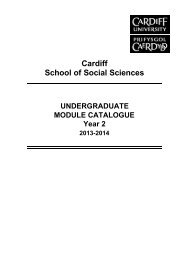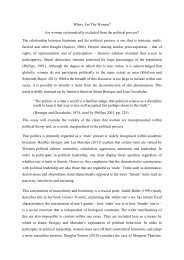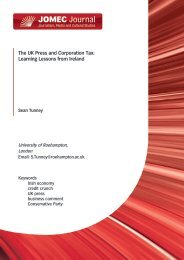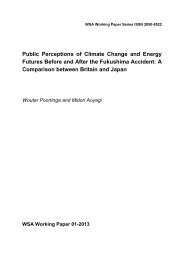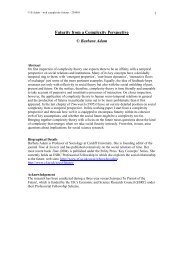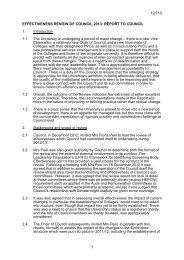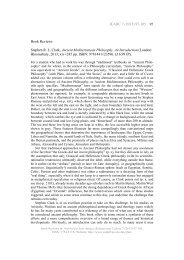APHRODITE IN PROCLUS' THEOLOGY - Cardiff University
APHRODITE IN PROCLUS' THEOLOGY - Cardiff University
APHRODITE IN PROCLUS' THEOLOGY - Cardiff University
Create successful ePaper yourself
Turn your PDF publications into a flip-book with our unique Google optimized e-Paper software.
JLARC 3 (2009) 21-43 37<br />
At the same way the magical girdle and the aid of Aphrodite renders Hera even more<br />
a likeness of Rhea (translation mine).<br />
Here Proclus indicates the highest location at which we can already see Aphrodite<br />
as an articulated deity, with a primordial identity, albeit yet without her own<br />
name, preexisting in her first cause. In my opinion Proclus is referring to the gods<br />
in the second term of the noetic-noeric class. There, according to the words of<br />
Proclus,<br />
In Remp. 1.139,3-5.: ἦν γὰρ καὶ ἐκεῖ τῆς θεοῦ ταύτης προϋφεστῶσα μονάς, ἄνωθεν<br />
ἀπὸ τῆς συνεκτικῆς τοῦ Οὐρανοῦ θεότητος διὰ μέσου Κρόνου προελθοῦσα καὶ<br />
καταλάμψασα πᾶσαν τὴν νοερὰν ζωὴν τῷ φωτὶ τοῦ κάλλους<br />
preexists the monad of this goddess who maintains Uranus, who makes her procession<br />
through the domain of Cronus and illuminates the whole of intellective life with the<br />
light of beauty (translation mine).<br />
Locating Aphrodite’s first monad in this level which articulates itself again into<br />
subtriads, is consistent as we remember, that the divine love, the first Eros, is the<br />
third term of noetic-noeric triad. 62 If Aphrodite is Erotokos, surely her monad<br />
should be on the higher level as the first monad of Eros.<br />
Proclus furthermore analyzes the different ways in which Aphrodite and Hera bear<br />
the girdle:<br />
In Remp. 1.139,6-13.: ἡ μὲν Ἀφροδίτη τὸν κεστὸν ἐν τῷ στήθει λέγεται φέρειν, ὡς<br />
ἂν προβεβλημένας αὐτοῦ τὰς δυνάμεις ἔχουσα·ἡ δὲ Ἥρα κρύπτει πως αὐτὸν ὑπὸ<br />
τοῖς κόλποις, ὡς ἂν ἄλλην μὲν ἰδιότητα λαχοῦσα τῆς ὑπάρξεως, ἔχουσα δὲ καὶ τὸν<br />
κεστόν, καθ’ ὅσον καὶ αὐτὴ πεπλήρωται τῆς ὅλης Ἀφροδίτης. οὐ γὰρ ἔξωθέν<br />
ποθεν ἐπάγεται τὴν συνάπτουσαν αὐτὴν πρὸς τὸν δημιουργὸν δύναμιν, ἀλλ’ ἐν<br />
ἑαυτῇ καὶ ταύτην συνείληφεν.<br />
Aphrodite holds it in her bosom in such a manner that she keeps its powers exposed.<br />
Hera hides it in her chest, because her mode of existence is different, even if she<br />
too has a magical girdle in so far as she is filled with all the qualities of Aphrodite.<br />
She does not evoke the power, by which she unites with the demiurge by some external<br />
means, but she has enclosed this power in herself (translation mine).<br />
Uneducated but pious common opinions also emphasize the connection between<br />
the two goddesses as they respect Hera as mistress of the union of consorts and<br />
protectress of marriage. She unites with the demiurge with the aid of the magical<br />
girdle, which is in herself, and creates connections in the legitimate bonds of<br />
62 The common monads for all the goddesses’ situate themselves higher, on the first level of the<br />
noetic-noeric triad. Theol. Plat. 4.16; 4.48,19 22, also 4.89,9: θηλυπρεπής ἐστι πρῶτος (first feminine<br />
being) and even on the first intelligble triad where is τὸ πρώτιστον θῆλυ (first femine principle)<br />
4.92,2. which is the (ἑτερότης) first otherness.<br />
Tuomo Lankila, ‘Aphrodite in Proclus’ Theology,’ in: Journal for Late Antique Religion and<br />
Culture 3 (2009) 21-43; ISSN: 1754-517X; Website: http://www.cardiff.ac.uk/clarc/jlarc




